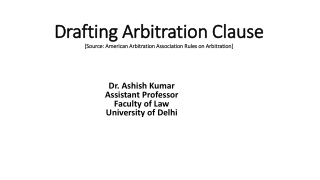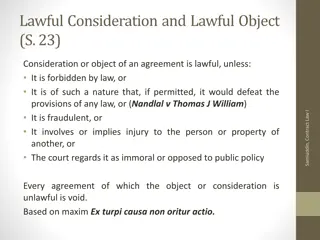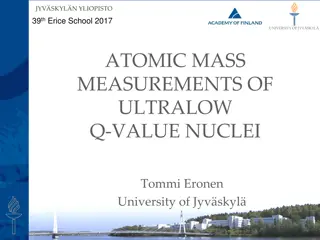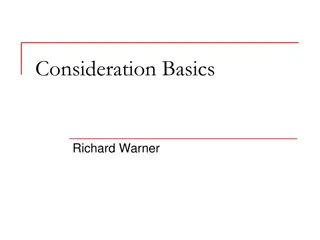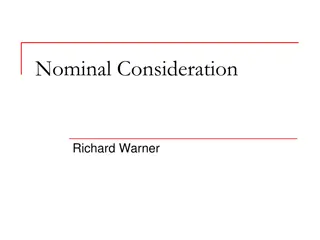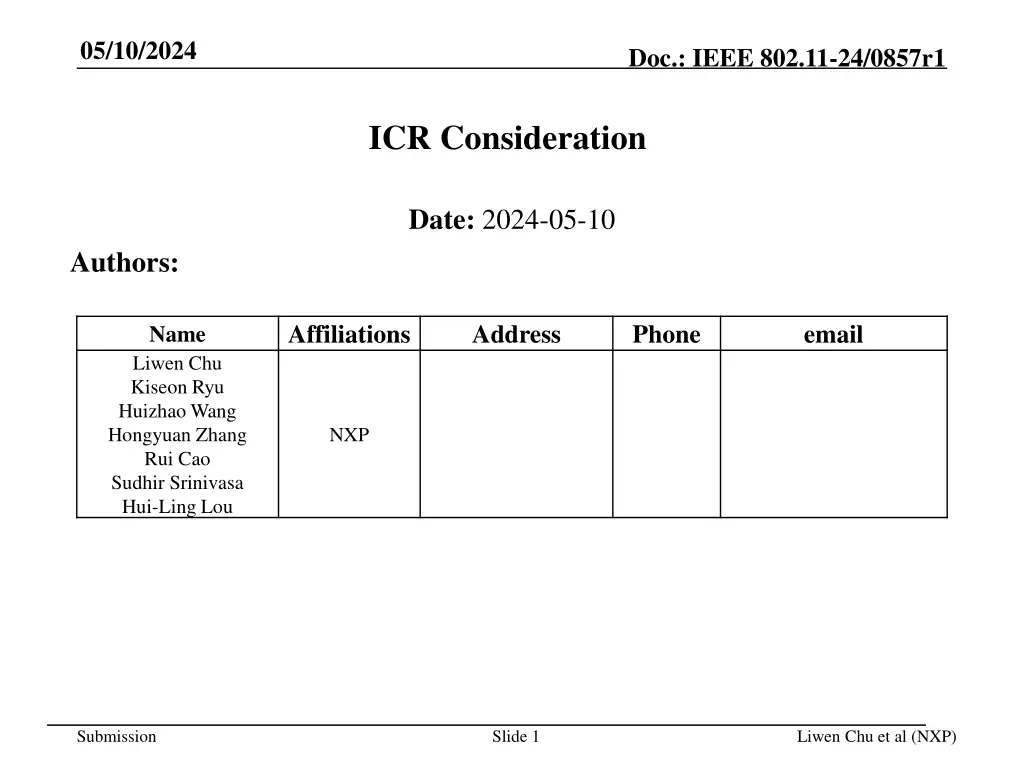
IEEE 802.11-24/0857r1 ICF/ICR Consideration Summary
In this document, the authors from NXP discuss the usage of ICF/ICR in IEEE 802.11-24/0857r1 for control information negotiation in wireless communication, covering topics such as power management, interference co-existence, and frame exchanges. Different options and implementations are explored, focusing on improving initial control information handling for efficient communication.
Download Presentation

Please find below an Image/Link to download the presentation.
The content on the website is provided AS IS for your information and personal use only. It may not be sold, licensed, or shared on other websites without obtaining consent from the author. If you encounter any issues during the download, it is possible that the publisher has removed the file from their server.
You are allowed to download the files provided on this website for personal or commercial use, subject to the condition that they are used lawfully. All files are the property of their respective owners.
The content on the website is provided AS IS for your information and personal use only. It may not be sold, licensed, or shared on other websites without obtaining consent from the author.
E N D
Presentation Transcript
05/10/2024 Doc.: IEEE 802.11-24/0857r1 ICR Consideration Date: 2024-05-10 Authors: Affiliations Address Phone email Name Liwen Chu Kiseon Ryu Huizhao Wang Hongyuan Zhang Rui Cao Sudhir Srinivasa Hui-Ling Lou NXP Submission Slide 1 Liwen Chu et al (NXP)
05/10/2024 Doc.: IEEE 802.11-24/0857r1 Recap: Candidate ICF/ICR The ICF/ICR is used for the initial control information negotiation/notification e.g. in-device interference co-existence, power save low-capacity listening mode. The ICF/ICR also needs to act as initial frame exchange for EMLSR, TXOP protection the same way as RTS/CTS Frame exchange initiated by an AP Option 1: BSRP Trigger and Multi-STA BA. Option 2: BSRP Trigger and QoS Null Option 3: New Trigger variant and new control responding frame. Frame exchange initiated by a non-AP STA Option 1: BAR and Multi-STA BA when soliciting device is a non-AP STA. Option 2: BSRP Trigger and Multi-STA BA. Option 3: New Trigger variant and new control responding frame Submission Slide 2 Liwen Chu et al (NXP)
05/10/2024 Doc.: IEEE 802.11-24/0857r1 Per-User and Common Initial Control Information Per-user initial control information In a broadcast ICF, the AP can announce the maximal Nss, BW for a STA s power save that the AP will ask the STA to use for the DL MU PPDU reception and UL TB PPDU transmission. In a broadcast Multi-STA BA, the AP can transmit the in-device interference for a STA besides the BA acknowledgement for the STA. This is useful when the AP has interference and receive part or no MPDUs from a STA in the STA s RU. Common initial control information In a unicast ICF or ICR, the initial control information is the common initial control information. In a broadcast ICF or ICR, the initial control information for all addressed/associated UHR STAs is the common initial control information, e.g. The AP s unavailable time. Submission Slide 3 Liwen Chu et al (NXP)
05/10/2024 Doc.: IEEE 802.11-24/0857r1 Multi-STA BA vs QoS Nulland ICR with New Control Subtype (1) The QoS Null can be used when no additional initial control information is carried in responding frame. The HE Control field in a QoS Null frame may have no enough room to carry the required initial control information. The variable length HE Control field can provide enough room. However, it requires the additional change to HE Control field. The ICR with the new control subtype provides the enough room for carrying the initial control information. However, this increases the additional control subtype decoding. Submission Slide 4 Liwen Chu et al (NXP)
05/10/2024 Doc.: IEEE 802.11-24/0857r1 Multi-STA BA vs QoS Null and ICR with New Control Subtype (2) BA in mmWave band provides the traffic load control besides acknowledging the soliciting A-MPDU. Multi-STA BA can be used as unicast and broadcast frame. Multi-STA BA can carry additional control information besides BA bitmap to acknowledging A-MPDU(s) and/or MPDU(s). It is easy to carry per-user initial control information and initial control information for all addressed STAs. Adding in-device coexistence information (e.g. unavailable time notification) is harmonized with the other Multi-STA BA enhancement. When being used as ICR solicited by ICF, a Multi-STA BA may not need to carry BA Bitmap field for acknowledging the frames in the A-MPDU(s). Multi-STA BA needs to be ICR at least when the ICR carries the feedbacks (i.e. unavailability feedback). Submission Slide 5 Liwen Chu et al (NXP)
05/10/2024 Doc.: IEEE 802.11-24/0857r1 Common Initial Control Info in ICR Multi-STA BA (1) The Common Initial Control Info field carries one, or multiple Common Initial Control Per AID TID Info fields. The AID11 field with a special value, e.g. 2012, in a Per AID TID Info field indicate that the Per AID TID Info field is the Common Initial Control Per AID TID Info field. Each Common Initial Control Per AID TID Info field has the Common Initial Info field with 4, 8, 16, 32, 64, 128 octets. The Fragment Number subfield indicates the length of Common Initial Info field. The same coding of Fragment Number subfield for the length of Block Ack Bitmap field is used. Padding Padding Security Per AID TID Padding Padding with Per AID TID Info List Per-STA Initial Control Info List Common Initial Control Info Variable 18 Variable Common Initial Control Per AID TID Info Common Initial Control Per AID TID Info Common Initial Control Per AID TID Info field 0, 1, or more Common Initial Control Per AID TID Info fields Common Initial Info 2 4, 8, 16, 32, 64, 128 Specific AID value, e.g. 2012 Submission Slide 6 Liwen Chu et al (NXP)
05/10/2024 Doc.: IEEE 802.11-24/0857r1 Common Initial Control Info in ICR Multi-STA BA (2) The combination of the Common Initial Control Per AID TID Info field(s) in a Common Initial Control Info field satisfies. The Common Initial Control Per AID TID Info field(s) carries all the required common initial control information. The number of the Common Initial Control Per AID TID Info field(s) in the Common Initial Control Info field is smallest compare any other combinations of Common Initial Control Per AID TID Info field(s) to carry the required common initial control information. The unused bits in Common Initial Info field(s) are least compare any other combinations of Common Initial Control Per AID TID Info field(s) to carry the required common initial control information. Only the Common Initial Info field in the last Common Initial Control Per AID TID Info field has unused bits. Submission Slide 7 Liwen Chu et al (NXP)
05/10/2024 Doc.: IEEE 802.11-24/0857r1 Per-STA Initial Control Info in ICR Multi-STA BA (1) The initial control information for a STA can be carried after the Common initial control information. The Per-STA Initial Control Info field carries one, or multiple Per-STA Initial Control Per AID TID Info fields. The AID11 field with addressed STA s AID, in a Per AID TID Info field indicate that the Per AID TID Info field is the Per-STA Initial Control Per AID TID Info field. This is suitable for uncast Multi-STA BA. Each Per-STA Initial Control Per AID TID Info field has the Per-STA Initial Info field with 4, 8, 16, 32, 64, 128 octets. The Fragment Number subfield indicates the length of Common Initial Info field. The same coding of Fragment Number subfield for the length of Block Ack Bitmap field with the exception B0 usage is used. Per-STA Initial Control Per AID TID Info field Per-STA Initial Info 2 4, 8, 16, 32, 64, 128 Submission Slide 8 Liwen Chu et al (NXP)
05/10/2024 Doc.: IEEE 802.11-24/0857r1 Per-STA Initial Control Info in ICR Multi-STA BA (2) The combination of the Per-STA Initial Control Per AID TID Info field(s) in a Per-STA Initial Control Info field satisfies. The Per-STA Initial Control Per AID TID Info field(s) carries all the required per-STA initial control information. The number of the Per-STA Initial Control Per AID TID Info field(s) in the Per-STA Initial Control Info field is smallest compare any other combinations of Per-STA Initial Control Per AID TID Info field(s) to carry the required per-STA initial control information. The unused bits in Per-STA Initial Info field(s) are least compare any other combinations of Per-STA Initial Control Per AID TID Info field(s) to carry the required per-STA initial control information. Only the Per-STA Initial Info field in the last Per-STA Initial Control Per AID TID Info field has unused bits. Submission Slide 9 Liwen Chu et al (NXP)
05/10/2024 Doc.: IEEE 802.11-24/0857r1 Summary The various candidate ICRs are compared We prefer Multi-STA BA as ICR at least when carrying the feedbacks. The frame format of ICR Multi-STA BA is discussed. Submission Slide 10 Liwen Chu et al (NXP)
05/10/2024 Doc.: IEEE 802.11-24/0857r1 SP 1 Do you support to use M-STA BA for Initial Control Response frame (ICR) for DL and UL, at least when carrying feedbacks (i.e. unavailability feedback)? Submission Slide 11 Liwen Chu et al (NXP)


